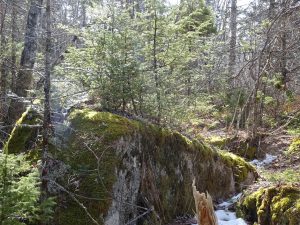
Each generation must make their own journey through a thick terrain.
How ever we get lost along the way, let us rejoice in the healing steps that follow.
I hope we all continue to gather at the edge of the woods where the generations before us and after us re-merge.
– Prologue to Generations Re-Merging by Shalan Joudry
A reader of NSFN forwarded some stats and some thoughts about the future of the forest industry, writing as one who comes from a family directly involved in forestry for three generations. He arrives at a painful conclusion: “I sometimes wonder”, he writes, “if our Provincial Governments (of all stripes) have been trying to delay the inevitable, the closure of the forestry industry”.
I wish we could recognize ‘the inevitable’ as the reader put it, and work collectively to make the transition to a very different kind of forest economy, one that would allow our Wabanake/Acadian forest to thrive and be as resilient as possible in times of great climate and social change and provide stable, rewarding employment for all of the workers now working in large scale, industrial forestry, and more.
Received today from a reader of NSFN:
‘Came across the following site:
‘Still trying to reconcile the total number of jobs that Forestry Nova Scotia’s site highlights (11,500)
Logging/forestry 625 Support 390 Sawmills 700 Veneer 335 Other 535 Paper 1005 Total 3590 The latter number suggests that less than 1% of the provincial labour force is involved with “forestry”.
& a followup comment Dec 23, 2021:
I also came across the following site. Focus appears to be immigration, and highlighting how “attractive” Nova Scotia is. What stood out was the comment regarding traditional resource based industries, including forestry, are in decline. This suggests that “outsiders” are looking at the state of the industry and making an independent assessment.
Overview of Nova Scotia’s economy, Canada (odinland.vn)
If the 2020 forestry employment numbers are correct, a significant amount of money is being invested to prop up these jobs, and the Province is scrambling to support a vocal industry. Offset with fewer jobs, minimal stumpage fees to the province and actual dollars remaining here. Cheap raw materials, subsidized operating costs provide an ideal model for resource extraction and maximized profits and shareholder returns and dividends.
Wondering if anyone has done a serious analysis of the cost to produce a roll of TP, retail price paid by consumers, and returns to the corporate coffers. Time for our local economists to speak up.
If our forests are to become ecologically sustainable, it may be time to call for a complete halt to the industrial style harvesting being carried out by the multinational corporations. We should have learned by now that we have outstripped the pace at which the “resource” can be renewed naturally. We also appear to have forgotten any lessons learned following the Cod Moratorium that came into place in 1992.
I sometimes wonder if our Provincial Governments (of all stripes) have been trying to delay the inevitable, the closure of the forestry industry.
Thx, NSFN reader, for the update. His concluding statement was obviously one he did not make readily, telling me that “members of both of family lines have been directly involved in the forest industry for more than 3 generations”.
Indeed these employment numbers (for 2020) are hard to reconcile with those cited by Forest NS.
I wish we could recognize ‘the inevitable’ as the reader put it, and work collectively to make the transition to a very different kind of forest economy, one that would allow our Wabanake/Acadian forest to thrive and be as resilient as possible in times of great climate and social change and provide stable, rewarding employment for all of the workers now working in large scale industrial forestry, and more.
Related Post
– How important is Big Forestry to the Nova Scotia economy? 6Sep2021
The total employment numbers cited in that post were for 2018, when the total was 4,085.
